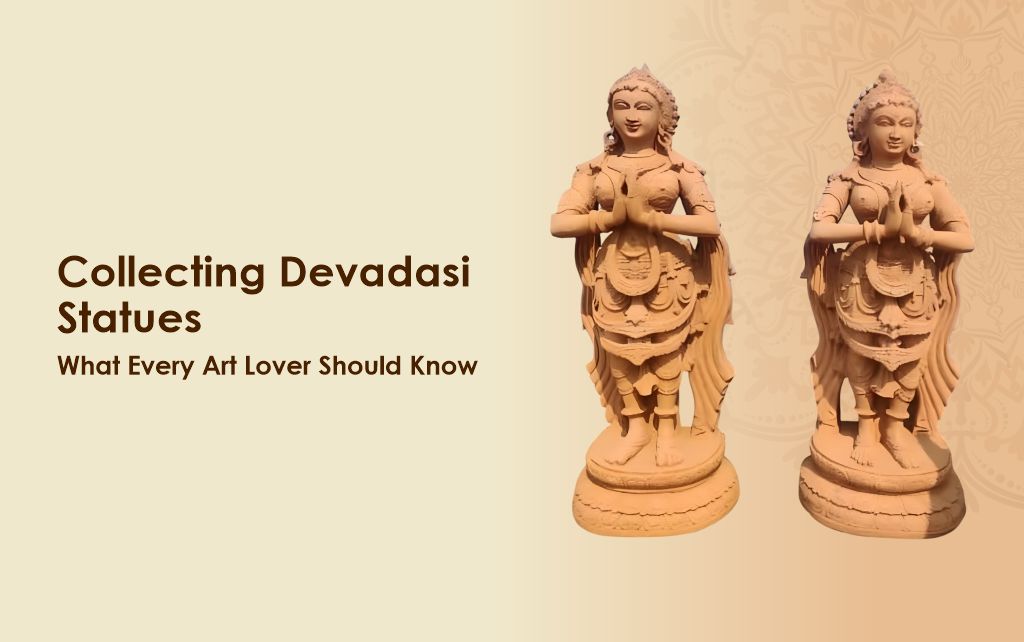Collecting Devadasi Statues: What Every Art Lover Should Know

Strong 8k brings an ultra-HD IPTV experience to your living room and your pocket.
India’s rich cultural heritage is a treasure trove for art lovers, and among its many artistic traditions, the stone carvings of Odisha stand out for their intricate beauty and historical significance. Devadasi statues, in particular, are captivating works of art that embody the spiritual, cultural, and artistic legacy of Odisha. These sculptures, often crafted from Khondalite stone, represent temple dancers who played a vital role in India’s religious and cultural history. For collectors and enthusiasts, understanding the nuances of collecting devadasi sculptures can deepen appreciation and ensure informed decisions. This blog explores the history, craftsmanship, cultural context, and practical aspects of collecting these exquisite pieces, offering insights for art lovers across India.
The Historical Significance of Devadasi Statues
Who Were the Devadasis?
Devadasis, often referred to as “God’s maids,” were women dedicated to serving temples in ancient India, particularly in South India and Odisha. From the 10th century onwards, they were revered for their devotion, performing ritual dances and music in honour of deities like Lord Krishna or Lord Jagannath. Their role was integral to temple culture, blending spirituality with art. Devadasi statues capture these women in graceful dance poses or playing musical instruments, symbolising their sacred connection to the divine.
The tradition of devadasis flourished in regions like Odisha, Andhra Pradesh, Tamil Nadu, and Karnataka, with each area contributing unique artistic interpretations. In Odisha, these sculptures are often found in temples like the Konark Sun Temple and the Mukteshwar Temple, showcasing the region’s mastery in stone carving. For collectors, devadasi statues are not just art pieces but windows into a bygone era of devotion and artistry.
The Cultural Context
Devadasi sculptures are deeply rooted in Odisha’s temple architecture, particularly the Kalinga School, which flourished from the 6th to 13th centuries. These statues often adorn temple walls, pillars, and gateways, depicting dancers in intricate poses that reflect classical dance forms like Odissi. The sculptures are more than decorative; they narrate stories of devotion, mythology, and human expression, making them valuable cultural artefacts. For art lovers, collecting these statues means preserving a piece of India’s spiritual and artistic heritage.
The Art of Stone Carving in Odisha
Khondalite Stone: The Heart of Devadasi Sculptures
One of the defining features of devadasi sculptures is the use of Khondalite stone, a foliated metamorphic rock with a distinctive reddish-brown hue. This stone, sourced from regions like Kenthumundi in Odisha, is prized for its durability and ability to hold intricate carvings. Its texture allows artisans to create detailed designs, capturing the elegance of a dancer’s posture or the delicate folds of her attire. Khondalite stone’s unique aesthetic adds a warm, earthy tone to devadasi statues, making them stand out in any collection.
Other stones like sandstone, soapstone, and granite are also used in Odisha’s stone carving tradition, but Khondalite remains the most iconic for devadasi sculptures. Its slightly harder composition compared to soapstone ensures longevity, making it ideal for both indoor and outdoor display. Art lovers should prioritise pieces made from Khondalite stone for their authenticity and visual appeal.
The Craftsmanship Behind Devadasi Statues
Stone carving in Odisha is an ancient craft, dating back to the 13th century, with artisans known as ‘Maharanas’ passing down their skills through generations. These craftsmen, often based in Puri and Bhubaneswar, create devadasi sculptures with remarkable precision, carving intricate details like jewellery, facial expressions, and flowing garments. The process involves selecting high-quality stone, sketching designs, and using chisels to bring the figures to life. Each statue is a labour of love, often taking weeks or months to complete.
For collectors, understanding the craftsmanship is key to appreciating a statue’s value. Look for pieces with fine detailing, such as the curve of a dancer’s waist or the texture of her ornaments, as these indicate superior artistry. Handcrafted devadasi sculptures, especially those made in traditional styles, are highly sought after for their authenticity and cultural significance.
Why Collect Devadasi Statues?
Aesthetic Appeal
Devadasi statues are celebrated for their aesthetic beauty, blending grace, movement, and spirituality. Whether it’s a dancer in a classic Odissi pose or a figure playing a musical instrument, these sculptures add elegance to any space. Their intricate designs and vibrant expressions make them perfect for home décor, meditation areas, or even outdoor gardens. The reddish-brown hue of Khondalite stone complements both modern and traditional interiors, offering versatility for collectors.
Cultural and Historical Value
For art lovers in India, collecting devadasi statues is a way to connect with the country’s rich heritage. Each sculpture tells a story of Odisha’s temple culture, its devotion to deities like Lord Jagannath, and its contribution to Indian art. These pieces are not just decorative but carry historical weight, representing centuries-old traditions. Collectors can take pride in preserving this legacy while showcasing the artistry of Odisha’s craftsmen.
Investment Potential
Beyond their cultural and aesthetic value, devadasi sculptures can be a sound investment. Handcrafted pieces, especially those made by skilled artisans, tend to appreciate over time due to their rarity and craftsmanship. As interest in traditional Indian art grows globally, these statues are increasingly sought after by collectors, making them a valuable addition to any art collection.
Tips for Collecting Devadasi Statues
Authenticity and Provenance
When collecting devadasi statues, authenticity is paramount. Ensure the sculpture is handcrafted by artisans from Odisha, preferably using Khondalite stone or other traditional materials like sandstone or granite. Ask for details about the statue’s origin, including the artisan’s credentials and the region where it was crafted. Authentic pieces often come with a story, such as the temple or dance form that inspired the design.
Avoid mass-produced replicas, which lack the soul and precision of handcrafted works. Check for signs of hand-carving, such as slight irregularities or unique detailing, which distinguish genuine sculptures from factory-made ones. If possible, source statues from reputable artisans or marketplaces in Odisha, such as Puri or Bhubaneswar, known for their stone carving heritage.
Size and Placement
Devadasi statues come in various sizes, from small figurines to large garden sculptures. Consider the space where you plan to display the statue. Smaller pieces are ideal for indoor settings like living rooms or altars, while larger ones can enhance outdoor spaces like gardens or courtyards. Ensure the statue’s size complements your décor without overwhelming the space.
For outdoor placements, verify that the statue is made from durable stone like Khondalite or granite, which can withstand weather conditions. Regular maintenance, such as dusting or occasional rinsing, will keep the sculpture looking pristine.
Customization Options
Many artisans in Odisha offer customization, allowing collectors to request specific designs, sizes, or poses. For instance, you could commission a devadasi statue in a particular dance mudra or with unique adornments. Custom pieces can add a personal touch to your collection, but they may take 45-60 days to complete, depending on complexity. Discuss your requirements clearly with the artisan to ensure the final piece meets your expectations.
Budget Considerations
The cost of devadasi statues varies based on size, material, and craftsmanship. Smaller pieces made from sandstone or soapstone may be more affordable, while large Khondalite stone sculptures crafted by master artisans can be pricier. Set a budget and priorities quality over quantity. Investing in a single, well-crafted piece is often more rewarding than purchasing multiple lower-quality replicas.
Ethical Collecting
When collecting devadasi statues, approach the process with respect for their cultural and spiritual significance. These sculptures often depict sacred figures tied to temple traditions, so treat them with reverence. Avoid displaying them in inappropriate settings, such as areas lacking dignity or sanctity. Additionally, support artisans by purchasing directly from them or through fair-trade platforms to ensure they receive fair compensation for their work.
Caring for Your Devadasi Statues
Maintenance Tips
Devadasi sculptures, especially those made from Khondalite stone, are durable but require basic care to maintain their beauty. For indoor statues, dust regularly with a soft cloth to prevent dirt buildup. Avoid harsh chemicals, as they can damage the stone’s surface. For outdoor sculptures, rinse occasionally with water to remove dust or debris, especially after heavy rain or dust storms.
If you notice cracks or chips, consult a professional restorer familiar with stone carvings. Avoid attempting repairs yourself, as improper handling can worsen the damage. Store smaller statues in a dry, stable environment to prevent accidental damage.
Displaying with Respect
When displaying devadasi statues, choose a location that highlights their beauty and cultural significance. A well-lit corner of your living room, a dedicated altar, or a garden nook can create a serene ambiance. Pair the statue with complementary décor, such as traditional Indian textiles or plants, to enhance its aesthetic appeal. For statues depicting deities or sacred figures, consider placing them in a space reserved for reflection or prayer.
Where to Find Devadasi Statues
Exploring Odisha’s Art Hubs
Odisha is the heart of devadasi sculpture production, with Puri, Bhubaneswar, and Konark being key hubs. Visiting these areas allows you to connect directly with artisans, witness their craft, and select authentic pieces. Local markets, craft fairs, and artisan workshops offer a range of statues, from traditional designs to modern interpretations.
Online Marketplaces
For collectors unable to travel to Odisha, online platforms provide access to a wide range of devadasi statues. Look for websites specialising in Indian handicrafts, ensuring they source directly from artisans. Check customer reviews and verify the authenticity of the pieces before purchasing. Be cautious of overly cheap deals, as they may indicate mass-produced replicas.
Art Fairs and Exhibitions
Art fairs, such as the Surajkund International Crafts Mela, showcase Odisha’s stone carvings, including devadasi statues. These events offer a chance to explore a variety of designs and meet artisans in person. Keep an eye on local and national art exhibitions, especially those focused on Indian heritage, to discover unique pieces for your collection.
The Future of Devadasi Statues
As interest in traditional Indian art grows, devadasi statues continue to captivate collectors worldwide. Artisans in Odisha are adapting to modern tastes, creating sculptures that blend traditional motifs with contemporary designs, such as candle stands or vases inspired by devadasi figures. This evolution ensures the craft remains relevant while preserving its cultural roots.
For art lovers, collecting devadasi statues is a journey of discovery, connecting you to Odisha’s rich artistic legacy. By understanding the history, craftsmanship, and care involved, you can build a collection that celebrates the beauty and spirituality of these timeless sculptures. Whether you’re a seasoned collector or a beginner, devadasi statues offer a meaningful way to engage with India’s cultural heritage.
Note: IndiBlogHub features both user-submitted and editorial content. We do not verify third-party contributions. Read our Disclaimer and Privacy Policyfor details.


